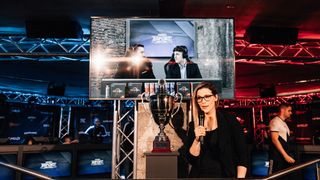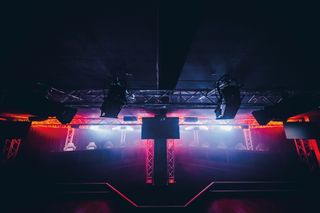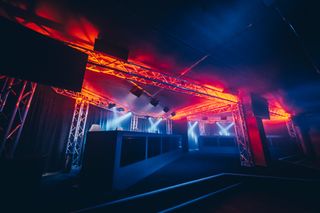Esports Training Factory, Moritz Esche: Expert Interview
Epsorts training facility plans for live-action and streaming

Audio + Video + IT. Our editors are experts in integrating audio/video and IT. Get daily insights, news, and professional networking. Subscribe to Pro AV Today
Esports training is still going on, and the gamers will be back in force at the new Esports Factory in Osnabrück, Germany. Moritz Esche, also known as Mo, is the Technical Director at media company Maze and he put their whole video, lighting and sound system together. He’s here to talk about it.
SVC: Esports. This has gotten to be such a huge thing in such a short time. It has really taken off and going like wildfire.
Mo Esche: Yeah, it absolutely is. I think now we have reached the one billion dollar goal, so it’s a pretty huge market all around the world.
And of course we’re under a very special situation here that we haven’t faced before. How is the esports community feeling about all of this?
I think we all are hit pretty hard by Covid-19 right now. But I think we need to stand together as a whole society and look forward and make the best out of it.
What’s your background in the Esports field?
Actually I’m not from an esports background. I went to university to get a bachelor’s degree in popular music production, so I came from a background of recording studios and the music business. But I was always interested in broadcast and streaming technology and technology as a whole. So I took all my knowledge and my experience in studio technology and shifted towards broadcast production.
Are you a pro? Subscribe to our newsletter
Sign up to the TechRadar Pro newsletter to get all the top news, opinion, features and guidance your business needs to succeed!
Well we certainly have that in common. What got you interested in esports and what’s the level of popularity with it?
Wow, it’s huge and it’s growing. So there are, I think, around half a billion people in the audience of esports globally. It’s great to be on the front line.

When you can get people together in this new facility at the Esports Factory it’s got to get absolutely crazy in there.
Yeah. I think you can totally compare it to all of the major sports leagues right now. t’s just huge at the moment.
So how did the Esport Factory project get started?
At the beginning of the Esport Factory the whole market was quite a new idea in Germany. The first thought was to build a premium boot camp for professional players as well as for non-professional or amateur gamers. Like you already said, it’s just a good thing to be together maybe as just friends or as a team in a competitive situation. In addition to that, we set up an event every year where we could host professional esport tournaments. And since esport has quite a natural online audience there was the immediate need to also build a production facility to livestream all of our events.
How does the boot camp facility work?
Yeah. Professional players need a place to come together and train with full focus because most of the teams are just working remotely. So they’re not together in one room. We built a facility where they can join and train and pick strategies. We put our focus on making everything as comfortable as possible for our guests and if needed we can cover a full-service experience including things like catering. We also have a gym. A lot of our teams make use of that since they need some sort of physical compensation for the training and full concentration.
And what is the Esports Academy?
We developed a concept with social workers and educationalists for our Esport Academy. Right now we’re on the search for partners to implement this in our location. We believe that there is a huge need for younger gamers not only to develop the skills and techniques in game, but also things like dealing with frustration, how to behave after I’ve lost a match, and of course, addiction prevention. We think that if younger gamers are taught by professional gamers and educationalists and social workers, that they will accept these lessons maybe a bit better than when they are taught in school. We’ve earned a lot of approval with this concept from teachers and educational institutions so I think we’re pretty unique with that. I think we take it as part of our responsibility that we need to prevent problems including addiction, and teach younger gamers especially, how to work and to have a stable career, actually, for a longer time.

So as the technical director what is your brief?
As technical director I was responsible for setting up the venue with my team, of course. I didn’t do it on my own. And our job was to do all the planning and thinking of what could go wrong at some point and how to prevent things from going wrong.
You know, it’s always the optimists who get caught unprepared.
[Laughs] Yeah, I think so too.
What was this facility before? How was it being used?
It was an office building so there were quite a few challenges when we reinvented the space to have a boot camp, event, and production facility. They had quite a good network infrastructure but everything else we needed to set up from scratch.
Did that include re-doing electrical wiring?
Yeah, of course a lot, because of the gaming PCs and all the event lighting and the cameras and everything drain a lot of power. So we teamed up with the local electrical company and we worked out a great way to fit all of our needs in that area.
You had long stretches. Something like nine kilometers of SDI cable and forty computers?
Yeah, 40 computers, 9 kilometers of SDI cables, like 100 video inputs, a few hundred meters of networking and audio. I think we tried everything to be connected everywhere in our facility so that we can even produce from our CEO’s office if needed.
You’ve got lighting, you’ve got sound, you have cameras—if things weren’t set up right it could be very easy to get hum bars in the video and noise in the sound. I’m sure you had to consider all of that, too.
Yeah, of course. We have several different circuits, of course, so that we can split up lighting and sound from video and so we don’t get all that distortion.

This is a really video-heavy environment so describe for us the video monitoring that was installed. You have a lot of displays to be keeping track of.
Yeah, we do have. We partnered with Samsung and they provided several of their high-end monitors. We combined several video hubs and video switchers to route all the pictures to the monitors where we needed them. And I’m not quite sure but I think we have around 100 video inputs – probably 96, I guess, and a few dozen outputs. But the cool thing is in most competitive esport games there’s something called a spectator mode. So we have some guys from our production crew that can join onto the server with the gamers and watch them playing the game from their perspective. So you can think of it like an in-game camera operator. This operator chooses which perspective we’re looking at in the livestream. We don’t need a whole lot of inputs because most of it is right on the server.
What sort of video format do you use to feed all of the monitors?
We’re working with HD SDI. We were thinking of NDI, and Dante for the audio. But we wanted to use the network infrastructure that was inside of the building; we didn’t want to expend it too much because it already was there. So we decided to spend our efforts on HD SDI and dedicated sound.
There are a lot of people involved in these productions and communication has got to be the key. What type of communication system did you set up for the Esport Factory?
Wow, yeah. We knew very early that we would need to have a good but also very, very flexible communication system because the needs in esports and in every tournament are different all the time. We set up a Clear-Com LQ Series intercom system. The main feature for us is actually the Agent-IC app, which is a mobile device app where you can connect to the base station via networks like Wi-Fi or even 4G if you need to.
How do you program and operate the Clear-Com system? Is that done from a central location?
Yeah. It actually is. For every production we have an individual setup because there’s no such thing as default. We have to set up or program the intercom system every time from scratch. But that is very, very easy with the LQ server.
How does the Clear-Com Agent IC mobile app work?
You can think of it like maybe a small base station. I think it’s a lot more powerful than a belt pack but not as powerful as a base station. You can connect as a certain user, say Camera 1 or something, we’ve already predefine in the programming before every show which different circles each position can talk and listen to. So the camera guy maybe talks to the technical director or producer, to the lighting operator, camera assistant or such and he hears program as well. Someone else will have a different circle. So even via 4G you can handle all of this.

When the Esports Factory fires back up, the gamers will be surrounded by sound, video, and shouting fans—a lot of sound sources all going at the same time. How is the sound system in there designed?
Oh, yeah, that was a great challenge. It was quite fun. We needed to stay quite flexible and modular with our sound system so we prepared for everything that can happen. We have dedicated stage boxes, audio mixers and everything we need, of course. We have a great PA inside of the facility.
I guess you would have to design the sound system so that there aren’t so many distractions that the players can’t concentrate.
We tried to keep it as simple as possible but as complex as needed.
Is there a central control point in that facility that controls the whole operation?
Oh, yeah, that’s our brain. It’s our control room. We have a dedicated room for the production crew. We have up to seven workstations, and we all work from that central location; so producers, technical directors, observer, lighting, sound guy, all together.
How did you do the lighting in there? How was it done to avoid glare on all of those video displays?
Oh, yeah, that’s not easy. We have ChamSys system. We have it in our central control room and we can control it. We can control every lamp separately, so especially the camera operators and the lighting technician are working closely together to prevent glares. But wherever possible we set up our monitors in a way to prevent lighting angles that could affect our production through glares.
Describe the remote connection aspect of it.
We do a lot of mobile productions or remote productions, usually in big facilities like sports arenas. Most of the time we tend to bring all of our equipment to the facility where we’re producing. But there are certain times and productions where we can keep some of the equipment basically at home and dial in remotely. We proved this with a production last year with our intercom, which was pretty great. We went to the facility and connected mobile devices to the Internet and our Clear-Com intercom system inside our facility is also connected to the Internet. Since it’s an IP-based system, we just opened a bunch of ports and we could actually could work on our base station but from 100 miles away.
Now that you’ve got this experience behind you, what’s the most important thing to do in planning a facility like this, because I’m sure there are going to be more of them?
My opinion is you have to stay totally open-minded to every situation that could occur so that you always can stay flexible and provide great services in many different situations. For example, we pulled cables to every room—I think it’s 13,000 square feet—so that we can do everything that may ever come.
